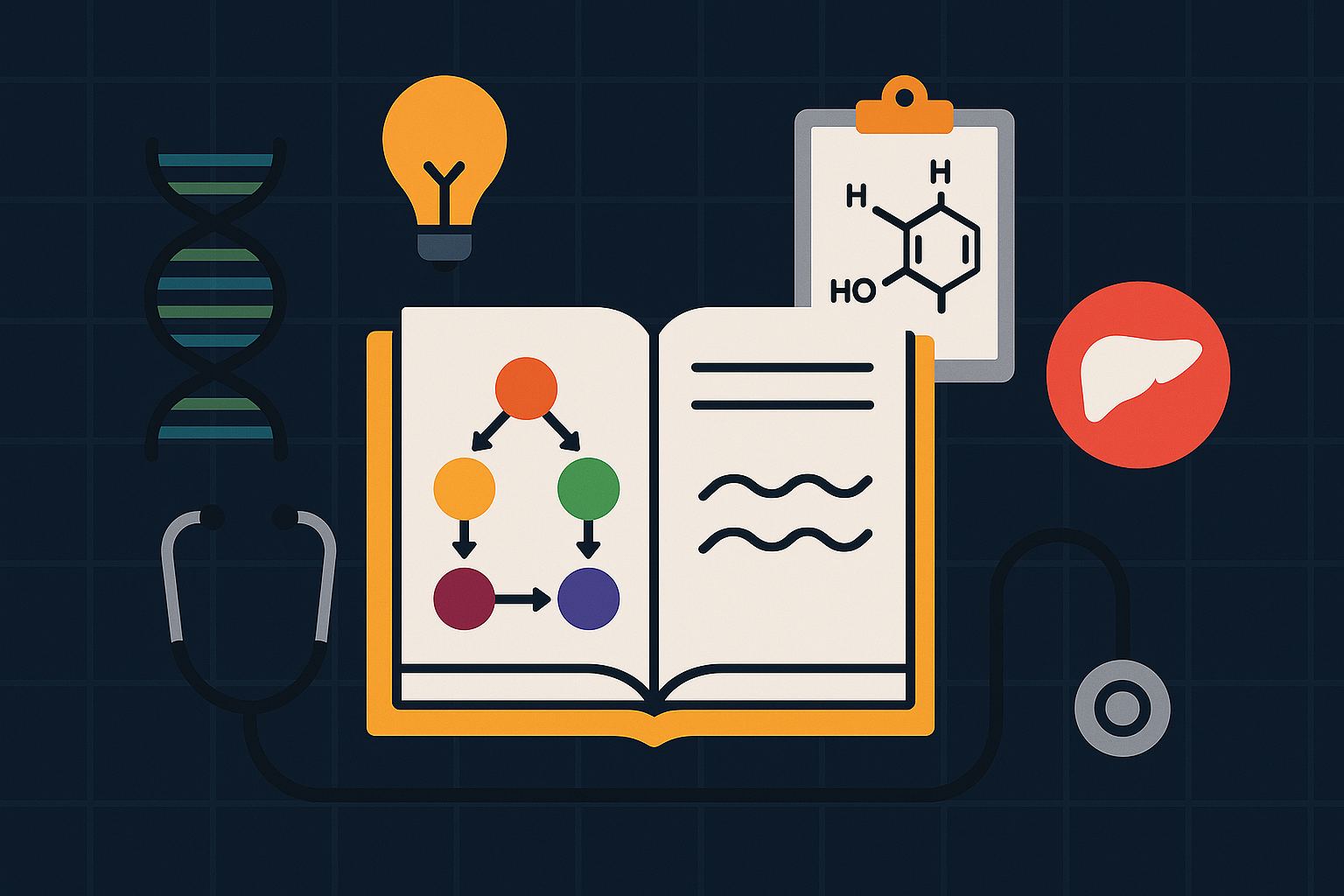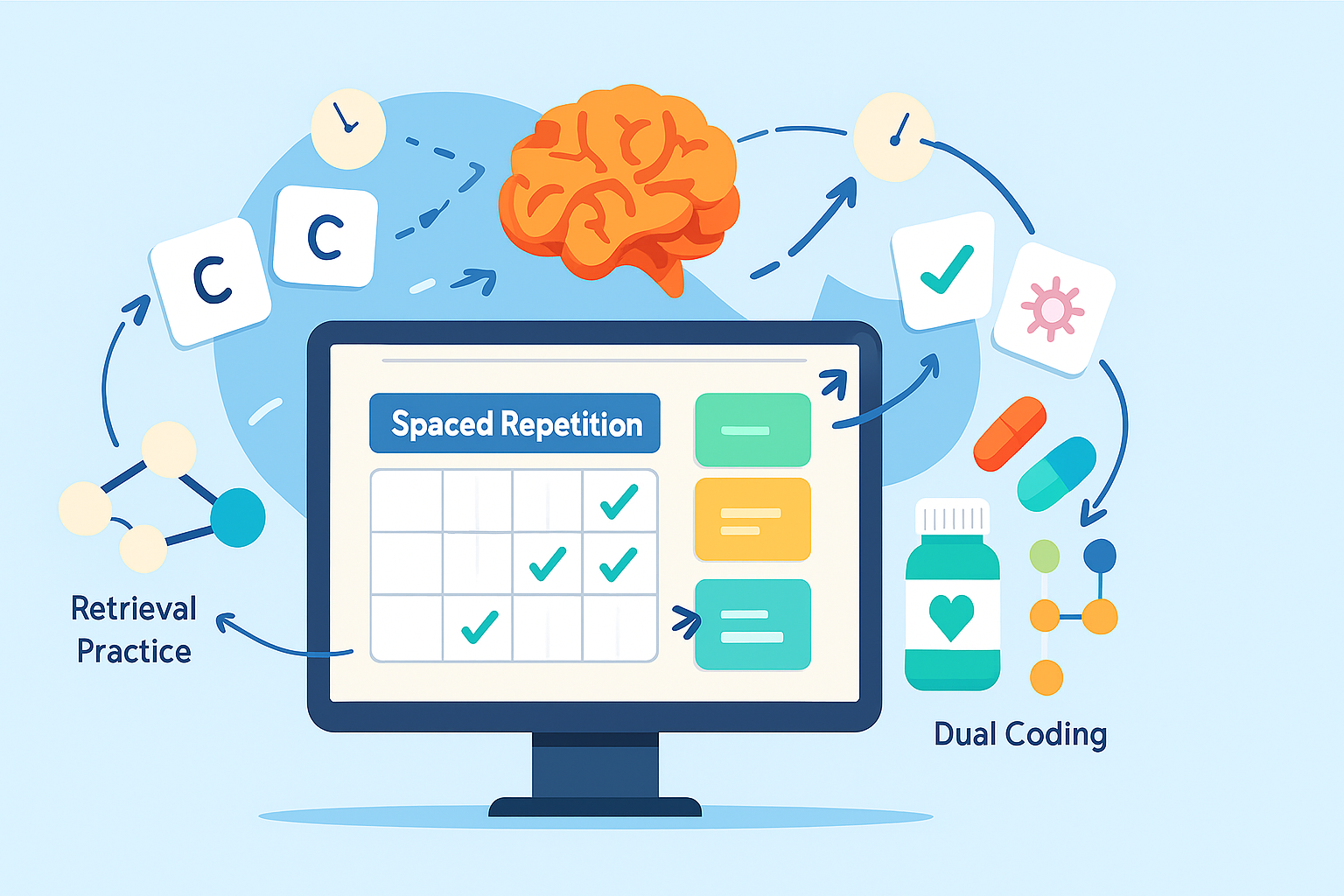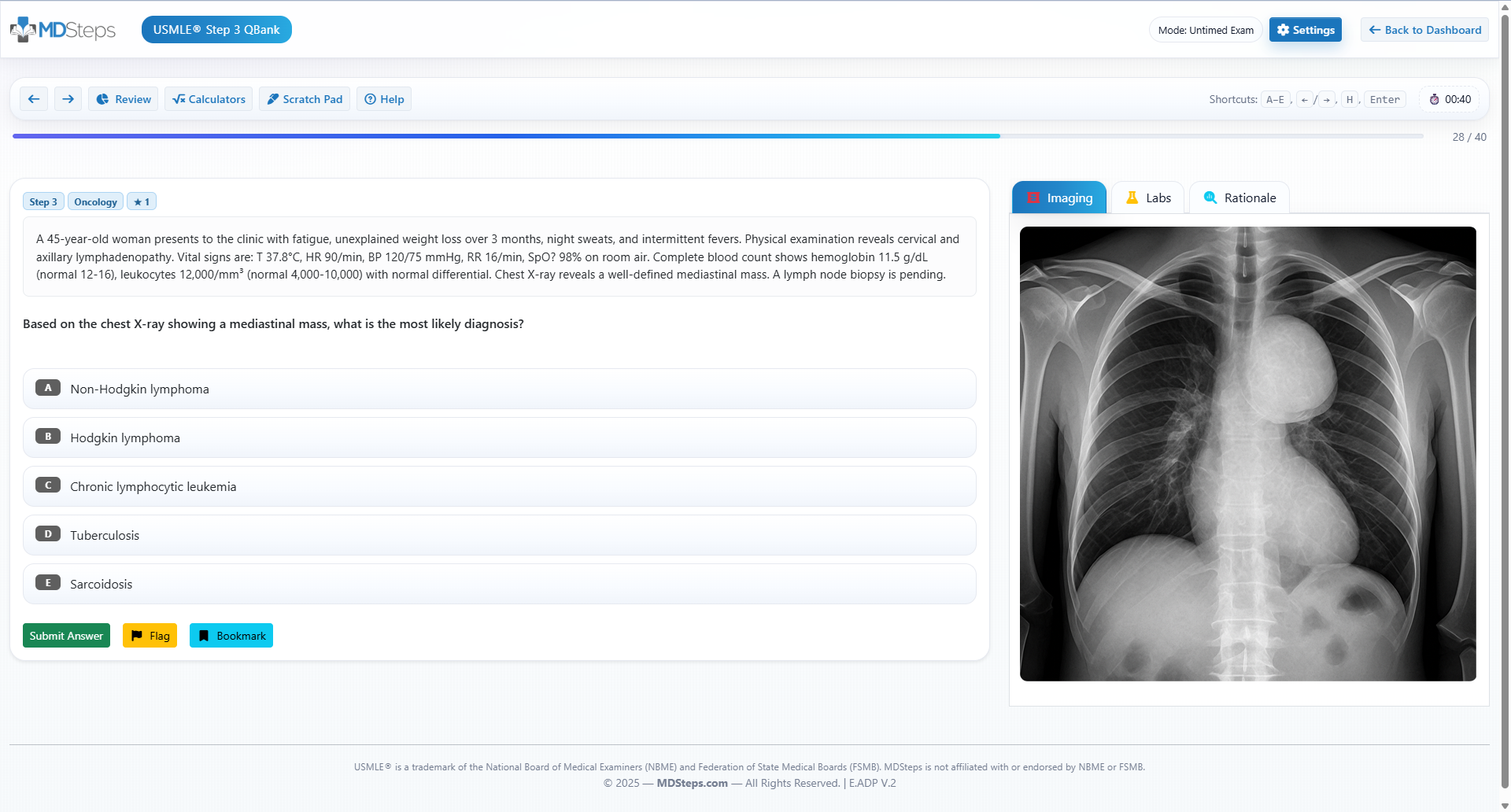Interleaving Systems Without Confusion: Daily AM/PM Study Model (Step 1)
A two-block day that alternates systems to boost transfer and retention while preventing “topic bleed.” Morning = high-quality encoding of one tightly bounded slice; evening = retrieval with mixed QBank + error-led micro-remediation. Pair systems across a 7-day loop to mirror Step 1’s integrated blueprint and build exam stamina.
Why Interleaving Works for Step 1 (and When It Doesn’t)
Step 1 increasingly rewards integrated thinking: path + phys + pharm + micro across organ systems. Interleaving—the deliberate alternation of topics or problem types—improves discrimination and transfer by forcing your brain to compare, contrast, and retrieve under shifting cues. In lab studies, interleaved practice outperforms blocked practice for category learning, concept application, and long-term retention. In exam terms, it helps you distinguish, for example, nephritic vs nephrotic presentations, shock phenotypes, or similar rashes driven by different mechanisms. The tradeoff is that interleaving feels harder and sometimes lowers short-term fluency; that “effort signal” is a desirable difficulty—not a failure of learning.
However, interleaving can backfire when boundaries are vague. If you “sort of” read about lupus nephritis and then wander into membranous nephropathy without explicit objectives, your encoding blurs, and evening retrieval becomes guesswork. The fix is a crisp AM/PM day structure with boundary cues (timers, objectives written in the margin, end-of-block mini-quiz) and a fixed rotation map that prevents ad hoc topic chasing. Interleaving must alternate units that are internally coherent (e.g., “cardiac murmurs: mechanisms & maneuvers”) rather than unfocused chapter skimming.
Three principles anchor the model: (1) Unitize AM content: one slice, two measurable objectives, one schema. (2) Switch on purpose in PM with mixed QBank blocks tuned to the morning’s slice plus 1–2 contrasting domains. (3) Close the loop using error-led micro-remediation (≤15 minutes) that edits your schema or flashcards. When you keep boundaries tight and feedback fast, you capture interleaving’s benefits (better cue use, cleaner category lines) without the confusion that kills momentum.
The AM/PM Day: Structure, Boundaries, and “No-Bleed” Rules
The day has two anchors. AM = Encoding (90–120 minutes). PM = Retrieval (90–120 minutes). Everything else (lectures, labs, life) fits around these anchors, which you treat as non-negotiable appointments. Each AM block defines two outcome-based objectives (“I can explain why HOCM gets louder with Valsalva” and “I can map murmurs to location/radiation/maneuvers”), builds a one-page schema, and closes with a 5-question rapid-probe quiz. You’ll protect this block from scope creep by writing the objectives before you open any resource and by ending on time even if the reading isn’t “done.”
PM converts the morning slice into evidence of retrieval. You run a timed mixed block (20–40 items), seeded with 25–50% from the morning system and the rest from one or two contrasting systems per your weekly rotation. Review uses a two-pass method: pass 1 verifies why the key is correct and why each distractor fails; pass 2 extracts the single fix (mechanism, differential discriminator, formula) that would have flipped your miss. Micro-remediation then updates a minimal “error ledger” or flashcard in ≤15 minutes.
No-bleed rules: (1) No new reading in PM. If you need background, add it to tomorrow’s AM objectives. (2) No “infinite review.” Limit PM review to 60–75 minutes after a 20–40 item block. (3) No ad hoc topic switches; follow the rotation map. (4) End both blocks with a boundary cue (timer + a tiny exit task—e.g., summarize the schema in 3 bullet points). Boundaries preserve cognitive energy and keep interleaving crisp rather than chaotic.
Your 7-Day Rotation Map: Pairings That Mirror the Exam
Build a weekly loop that alternates complementary or easily confusable domains. The goal is contrast without whiplash. Here’s a starting map for Step 1: Mon (Cardio ↔ Renal), Tue (Endocrine ↔ Repro), Wed (GI ↔ Heme/Onc), Thu (Neuro ↔ Psych), Fri (Micro ↔ Immuno), Sat (MSK/Derm ↔ Biochem/Biostats), Sun (Full mixed). Keep AM focused on a slice (e.g., “renal tubulopathies: channels & labs”), not a whole chapter. PM then mixes the day’s partner system plus 1–2 sprinkle items from the rest to prevent overfitting.
| Day | AM Focus (Encoding) | PM Mix (Retrieval) | Why This Pairing Works |
| Mon | Cardio slice (murmurs; shock) | 20–40 Qs: Cardio + Renal + 5 random | Hemodynamics + electrolytes → shared cues, distinct mechanisms |
| Tue | Endo slice (thyroid axes; DM drugs) | Endo + Repro + 5 random | Hormone axes; receptor logic vs pregnancy physiology |
| Wed | GI slice (cholestasis patterns) | GI + Heme/Onc + 5 random | LFT patterns vs anemia/cancer labs → differential discipline |
| Thu | Neuro slice (localization; tox) | Neuro + Psych + 5 random | Similar vignettes; different first-order explanations |
| Fri | Micro slice (gram-negatives; toxins) | Micro + Immuno + 5 random | Pathogens vs host response → clean comparator sets |
| Sat | MSK/Derm slice (rashes; myopathies) | MSK/Derm + Biochem/Biostats + 5 random | Pattern recognition vs calculation/interpretation |
| Sun | Short AM: consolidate misses | Full mixed 40-item simulation | Build exam stamina; integrate the week |
Customize pairings to your weaknesses. If endocrine is strong but renal acid-base trips you up, swap in an extra Renal slice on Tue AM and adjust PM mixes accordingly. Rebuild the map every 2–3 weeks as the distribution of misses shifts; interleaving is a strategy, not a cage.
Master your USMLE prep with MDSteps.
Practice exactly how you’ll be tested—adaptive QBank, live CCS, and clarity from your data.
What you get
- Adaptive QBank with rationales that teach
- CCS cases with live vitals & scoring
- Progress dashboard with readiness signals
No Subscriptions • No Credit Card to Start
Create your account
AM Block Playbook: Encode with Schemas, Not Paragraphs
Encoding that survives the afternoon relies on structure. Start with a 2-line problem statement (e.g., “Differentiate systolic vs diastolic murmurs by mechanism and maneuvers”). Then create a single-page schema that links mechanism → presentation → key exam/lab → next action. Think boxes and arrows, not prose. Fold in one worked example (classic board-style patient) and one near-miss (similar findings, different cause) to force feature discrimination.
Resource usage is surgical: First Aid or your primary outline defines the skeleton; Pathoma/Boards-style videos supply mechanism clarity; an image source (e.g., ECG/murmur audio, pathology images) provides cue fidelity so your later retrieval matches real stems. Keep note-making minimal. If it won’t be tested or won’t change an answer, it doesn’t go on the page. End with a 5-question rapid-probe: two straightforward, two discriminators, one “gotcha” aligned to your objectives. If a probe fails, don’t fix it now—tag the gap for PM retrieval.
Boundaries matter: set a 90–120 minute cap, write the two objectives at the top of the page, and add a visible stop signal (timer, calendar alarm). Close with a 30-second oral summary (literally explain your schema aloud) to strengthen recall pathways. By noon, you should have a crisp, test-shaped representation of the slice and a short list of uncertainties you’re eager to attack in PM.
PM Block Playbook: Mixed Qs, Two-Pass Review, Micro-Remediation
In the evening you turn encoding into evidence. Run a timed 20–40 item block, mixed across today’s pair plus a trickle from the rest of the blueprint. Aim for conditions close to the real test: no peeking, steady pacing, minimal interruptions. After submitting, conduct a two-pass review. Pass 1 confirms the key logic and disarms every distractor: name the wrong assumption that makes each incorrect option tempting (e.g., “I overvalued a nonspecific lab” or “I reversed cause→effect”). Pass 2 extracts a single modifiable unit—a mechanism, discriminator, or formula—and updates either your schema (one line) or a flashcard (one Q–A). If it takes more than 60–75 minutes, you’re over-processing; keep summaries short to preserve capacity for tomorrow’s AM.
| PM Setting | Recommended Value | Rationale |
| Block size | 30–40 (weekdays), 40 (Sun) | Balances power to detect weaknesses with review time |
| Mode | Timed, mixed | Mimics exam; prevents narrow overfitting |
| First pass review | ≤1 minute/item | Confirm why key is correct + each distractor fails |
| Micro-remediation | ≤15 minutes total | One actionable edit per miss (schema or card) |
Finish with a 3-item exit quiz from your morning page to prove retention under fatigue. If you miss two or more, schedule that slice again within 48–72 hours; otherwise it falls onto your spaced repetition ladder (1-3-7-14-30 days).
Metrics That Matter: A Three-Number Dashboard
Don’t drown in analytics. Track three numbers per day: (A) PM accuracy on mixed blocks (target trend ≥65% early, ≥75% late), (B) Discriminator saves (count of misses converted by a single added rule or mechanism), and (C) Lagged retention (score on next-day and 7-day re-probes of two morning objectives). These three tell you if encoding is crisp (A), if your reviews are surgical (B), and if memory is consolidating (C). If A is flat and B is low, you’re summarizing, not fixing. If C is low despite decent A, your spaced reviews are too sparse or your exit cues are weak.
Use a lightweight ledger (spreadsheet or cards) with one row per day. Color-code lagged probes (green ≥80%, yellow 60–79%, red <60%). Rebuild the weekly rotation when two consecutive days earn multiple red probes in the same domain—this indicates category confusion that interleaving can correct with different pairings. On Sundays, run a 40-item full-mixed to gauge stamina and transfer; compare its accuracy to weekday PM blocks. The gap should shrink over time as your evening practice and weekly map align to exam demands.
Minimal Daily Log
- AM objectives (2 bullets)
- PM block: size, % correct
- Discriminator saves (count + one example)
- Next-day probe score
When to Adjust
- <60% on two PM blocks in a row → shrink block to 20–25 and tighten AM scope
- Review >75 minutes → you’re over-annotating; enforce micro-remediation cap
- Repeated near-misses → add contrasting items to PM mix (not more reading)
Pitfalls, Safeguards, and the Rapid-Review Checklist
Common pitfalls. (1) Topic bleed: AM expands into adjacent chapters; PM drifts into reading. Safeguard: write two AM objectives and close with a 5-item probe; PM is questions only. (2) Review bloat: you rewrite textbooks in the margins. Safeguard: two-pass cap and single edit per miss. (3) Over-switching: too many domains in one PM block, creating whiplash. Safeguard: pairings + a small sprinkle (not chaos). (4) Illusions of fluency: high confidence but low lagged probes. Safeguard: always test next day and day 7.
Rapid-Review Checklist (use nightly, 3 minutes):
- Can I restate the AM schema in 3 bullets without notes?
- What single rule would have flipped my top PM miss today?
- Which distractor pattern fooled me (normal variant, reversed causality, wrong axis, base-rate neglect)?
- Did micro-remediation create one concrete edit (schema line or flashcard)?
- What two items will I probe tomorrow morning (objective #1 and #2)?
Fatigue and mindset. Interleaving is cognitively taxing. Build a pre-PM ritual (2–3 minutes: stretch, water, one deep breath, goal card). Use a hard stop and reward (walk, call a friend) to keep the routine sustainable. If life disrupts the day, salvage the PM block; retrieval drives consolidation even when encoding wasn’t perfect. Progress is the trend line across weeks, not the variance of a single day.
Deployment Blueprint: 4-Week Ramp and Exam-Week Taper
Week 1 (On-ramp): Set the rotation map and run smaller PM blocks (20–25 items) while you learn the cadence. AM slices are narrow: one mechanism or mini-differential. Focus on boundary cues and micro-remediation discipline. Expect lower PM accuracy; prioritize clean process over score chasing.
Week 2–3 (Build): Grow PM to 30–40 timed mixed items. Use Sunday full-mixed 40 as a stamina check. Rebuild the rotation if the same discriminator fails twice on day-7 probes. Keep daily tracking to three numbers. Replace sprawling reading with targeted schema edits and images that match test cues.
Week 4 (Sharpen): Hold the structure steady and push transfer: more contrast in PM mixes, especially among confusable pairs (e.g., obstructive vs restrictive lung patterns; nephritic vs nephrotic; microcytic etiologies). If accuracy is plateaued, shrink AM scope further and ensure every PM miss yields one concrete edit. Start short morning “recall walks” (explain yesterday’s schema aloud while walking 5 minutes).
Exam-week taper: 5–6 days out, reduce AM to 60–75 minutes of schema recalls and targeted image/audio cues; keep PM mixed but shorten review. Two days out, run a final 40-item mixed under test conditions; next day is light recall only; day before exam, stop new study by mid-afternoon, pack essentials, and sleep. The interleaving habit has already trained your switching stamina—trust it.
References & Further Reading
100+ new students last month.






